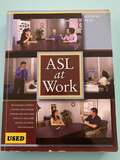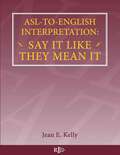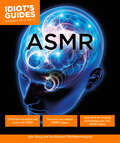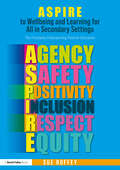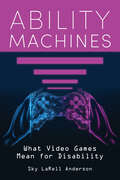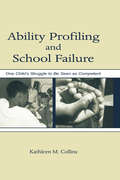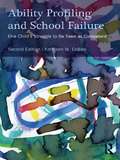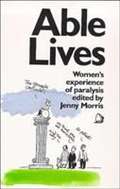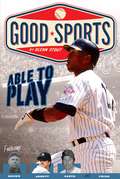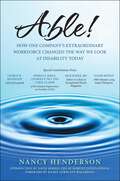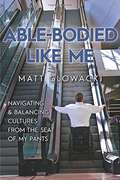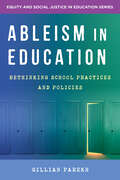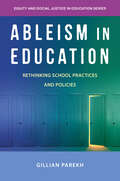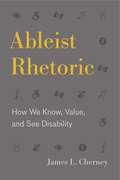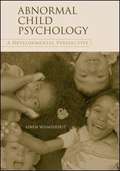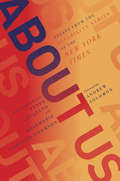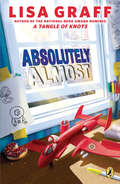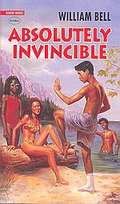- Table View
- List View
ARISE Impact Professional Introduction Module
by Nivisha Shah Renuka Sharma Paul Kniaz Srikanth Raviprasad Lakshita Duseja Maria Rojas Pillar Erandi Palihakkara Abhishek SyalARISE Impact’s Professional Introduction Module – Core’ prepares people with disabilities to present an effective introduction in professional settings such as job interviews. The book begins by discussing the meaning of a professional introduction. The first part of the book highlights the difference between a professional introduction and a casual introduction. It then presents an example of a professional introduction. Part three of the book examines different formats of a professional introduction as well as how and when a disability can be disclosed to a potential employer. The book concludes with three user stories that highlight the real-life experiences of individuals with visual impairments.
ASL Skills Development (The Effective Interpreting Series)
by Carol J. Patrie Joe Dannis Dawn Sign Press StaffPresents exercises to refine skills in American Sign Language. Topics include: main idea comprehension, summarizing, lexical substitution, paraphrasing of propositions and discourse, visual form, and meaning.
ASL at Work: Student Text
by Samuel K. Holcomb DawnSignPress Staff Rico Peterson William Newell Cynthia Ann Sanders Barbara Ray Holcomb Frank Caccamise National Technical Institute for the Deaf Department of American Sign Language and Interpreting Education StaffDivided into 16 instructional units ASL at Work is designed to enable students to develop the skills and knowledge needed to communicate effectively with their Deaf co-workers students and clients in work and social settings. <p><p>Each instructional unit in the Student Text has a Unit Overview with learning outcomes a listing of vocabulary full grammatical and language culture and community explanations and a practice and review section with accompanying DVD which provides students with targeted outside of the classroom practice to develop expressive and receptive skills. The Student Text is beautifully illustrated throughout with clearly drawn sign grammatical and vocabulary illustrations.Each unit on the ASL at Work Student DVD provides a Sample Expressive Dialogue Comprehension Dialogues and Narratives and demonstration of Expressive Practice Prompts to give students practice outside of the classroom with both receptive and expressive skills.
ASL-To-English Interpretation: Say It Like They Mean It
by Jean Elaine KellyThe focus of ASL to English: Say it Like They Mean It, is not about how we, the interpreters, think the English interpretation should be presented, but rather, how would an English speaking consumer with no understanding of Deaf Culture best understand the voiced message. The task of producing an appropriate interpretation from ASL to English is often noted as being the more difficult of the two interpreting tasks. With only two years in most interpreter education programs, students may not have a full comprehension of what is expected in ASL to English interpretation.This book looks at difficulties and issues that can arise as interpreters work between ASL and English, with exercises at the end of every chapter. ASL to English Interpretation: Say It Like They Mean It will not only give students currently studying interpreting an opportunity to learn how to interpret from ASL to English, but will also give students the opportunity to discuss and work on the task of the English interpretation with their teacher and fellow students.This book is identical to ISBN 0-916883-38-8, it is just perfect-bound instead of spiral-bound, which required a new ISBN.
ASMR (Idiot's Guides)
by Julie Young Ilse BlansertASMR stands for Autonomous Sensory Meridian Response. A way to beat insomnia and reduce stress, ASMR is a relaxed, tingling feeling that many people report having as a response to particular stimuli, such as close personal attention, tapping, or whispering. Idiot's Guides: ASMR offers a clear explanation of its benefits, different trigger types, and how to experience its effects. Bonus content includes exclusive interviews with the top ASMR artists and online video content.
ASPIRE to Wellbeing and Learning for All in Secondary Settings: The Principles Underpinning Positive Education
by Sue RoffeyThis truly accessible resource shows secondary school practitioners how to help make every child and young person feel like they really matter when they are in school, so they can develop confidence, resilience, love of learning, a positive sense of self and healthy relationships. Sue Roffey shows how to create a learning environment where all pupils can thrive and make progress in learning, and where wellbeing for everyone is at the heart of every school. By using the unique evidence-based ASPIRE principles of Agency, Safety, Positivity, Inclusion, Respect and Equity in practice, this insightful book shows teachers how to redress the balance in ways that maximise a love for learning, build a positive sense of self, construct healthy relationships, foster resilience and help young people make good choices. This resource features a chapter for each principle which explores what this means, why it matters and how it can be applied across secondary schools. Although visionary, the book is based on both substantial evidence and good practice, with each chapter supported by case-studies across the world. The book demonstrates the positive difference each principle makes to children in secondary school settings as well as teachers, parents and the overall community. It is a must-read for secondary school teachers, tutors, school leaders, psychologists, parents and anyone who wants an education system that is inclusive, holistic and effective for all students.
Abandoned: Now Stutter My Orphan
by Jerry HalvorsonAbandoned reveals the design and the outcome of the Monster Study in which orphans were made to stutter.
Ability Machines: What Video Games Mean for Disability (Digital Game Studies)
by Sky LaRell AndersonVideo games are both physically and cognitively demanding—so what does that mean for those with a disability or mental illness? Though they may seem at odds, Ability Machines illuminates just how vital video games are to understanding our bodies and abilities.In Ability Machines, Sky LaRell Anderson shows us how video games can help us imagine what our abilities mean and how they engage us physically, behaviorally, and cognitively to envision our agency beyond limitations. On the surface, this can mean games provide power fantasies; more profoundly, games can fundamentally reshape cultural and personal understandings of mental health, illness, disability, and accessibility. Video games are indeed ability machines that produce a reimagined state of agency. Featuring a comparative analysis of key video game titles, including Metal Gear Solid V, Wolfenstein II, Celeste, Devil May Cry 5, Hellblade: Senua's Sacrifice, Hades, Nier: Automata, and more, Ability Machines tackles larger questions of ability and how our bodies relate to interactive media.
Ability Profiling and School Failure: One Child's Struggle to Be Seen As Competent
by Kathleen M. Collins Kathleen M CollinsAbility Profiling and School Failure: One Child's Struggle to Be Seen as Competent explores the social and contextual forces that shape the appearance of academic ability and disability and how these forces influence the perception of academic underachievement of minority students. It is a powerful case study of a competent fifth grader, an African American boy growing up in a predominantly white, rural community, who was excluded from participating in science and literacy discourses within his classroom community. The case study form allows for the integration of the story of the student's struggle to be seen as competent in school, a context where his teacher perceives him as learning disabled, with Collins' own perspective as a researcher and teacher-educator engaged in a professional development effort with the teacher. The contribution of this book is to make visible the situated and socially constructed nature of ability, identity, and achievement, and to illustrate the role of educational and social exclusion in positioning students within particular identities. Highly relevant across the field of education, this book will particularly interest researchers, graduate students, and professionals in literacy and science education, curriculum and instruction, sociocultural theories of learning, discourse analysis of classrooms, research on teaching and learning, special education, social foundations, and teacher education.
Ability Profiling and School Failure: One Child's Struggle to be Seen as Competent
by Kathleen M. CollinsAbility Profiling and School Failure, Second Edition explores the social and contextual forces that shape the appearance of academic ability and disability and how these forces influence the perception of academic underachievement of minority students. At the book’s core is the powerful case study of a competent fifth grader named Jay, an African American boy growing up in a predominantly white, rural community, who was excluded from participating in science and literacy discourses within his classroom community. In this new edition, researcher and teacher-educator Kathleen Collins situates the story of Jay’s struggle to be seen as competent within current scholarly conversations about the contextualized nature of dis/ability. In particular, she connects her work to recent research into the overrepresentation of minority students in special education, exploring the roles of situated literacies, classroom interactions, and social stereotypes in determining how some students come to be identified as "disabled." Ability Profiling and School Failure, Second Edition comprises a thorough investigation into the socially constructed nature of ability, identity, and achievement, illustrating the role of educational and social exclusion in positioning students within particular identities.
Ability Structure and Loss of Vision
by Jyrki JuurmaaPsychological testing of the ability structures of the blind and sighted was commenced almost simultaneously during the first decades of this century. However, a majority of the studies concerning the blind, and the most crucial among them, sought to develop IQ-type test batteries, intended mainly for appraising their school achievement. By contrast, systematic studies have not been carried out to explore the relationships among different, mutually relatively independent traits and the quantitative contributions of such traits to different test performances. This lack of interest is perhaps due to the narrow range of occupations regarded as suitable for the blind: there has been no acute need for a more differentiated picture.
Able Lives: Women's Experience of Paralysis
by Jenny MorrisThis is a book written by spinal cord injured women who want to share their experiences with newly injured women and their friends and relatives, and to impress our concerns upon the general public and professionals. It is part of a growing movement to bring disability issues which previously have been kept private - behind the closed doors of individual lives - out into the open. We hope there will be many more books like this one to follow.
Able to Play: Overcoming Physical Challenges (Good Sports)
by Glenn StoutAble to Play shares the inspiring stories of four baseball players. Mordecai "Three Finger"Brown, Ron Santo, Jim Abbott, and Curtis Pride faced physical challenges other players didn't have. With determination and guts, they didn't just overcome; they excelled. This book is a game-changing celebration of overcoming odds.
Able!: How One Company's Extraordinary Workforce Changed the Way We Look at Disability Today
by Nancy HendersonIn a time when companies are outsourcing abroad, Habitat International, a Tennessee-based carpet manufacturer, has managed to achieve superior levels of productivity at home, often two to three times greater than its competition. Habitat's business has grown enormously, with much of its new business coming from work outsourced to them by competitors who could not come close to matching its productivity. Habitat's secret: they hire the people no one else will. At Habitat three of every four workers have a physical or mental disability. They earn normal wages and are cross-trained on every job. They work harder, with less supervision, lower turnover and an unparalleled level of loyalty. The challenges have been significant; the rewards extraordinary. This is Habitat's story. It's a powerful and moving tale of personal courage, deep commitment and challenging expectations. It's a story of success and personal triumph. It'll change the way you think about business … and the people around you.
Able-bodied Like Me: Navigating And Balancing Cultures From The Seat Of My Pants
by Matt GlowackiIn his insightful new memoir, Able-Bodied like Me, Matt Glowacki, civility speaker and author, chronicles the changing attitudes in our society—and in himself—about what it means to be disabled. <P><P>In the 1970s, when Glowacki was born, disabilities were still considered something to hide. Despite being born without legs, Glowacki pushed back against this narrative. He didn’t consider himself disabled and thought the term imposed unneeded limitations. He also balked at the tone-deaf remarks of others. He didn’t want to be an “inspiration” to people without impairments or a convenient way for others to signal their own virtue. Glowacki wanted to simply live his life, and he clearly explains how harmful certain remarks and actions can be for people in the disabled community. <P><P>In his memoir, Glowacki lists eighteen points to ponder as you reflect on your own assumptions and actions. Glowacki also examines his own changing beliefs about the term “disability,” as well as society’s shifting perspective. <P><P>As Glowacki shares the challenges he and others face in their everyday lives, he also offers suggestions about how to foster an environment of mutual respect and understanding. Glowacki certainly doesn’t want your pity. He just wants you to listen.
Ableism in Education: Rethinking School Practices And Policies (Equity and Social Justice in Education #0)
by Gillian ParekhHow we organize children by ability in schools is often rooted in ableism. Ability is so central to schooling—where we explicitly and continuously shape, assess, measure, and report on students’ abilities—that ability-based decisions often appear logical and natural. However, how schools respond to ability results in very real, lifelong social and economic consequences. Special education and academic streaming (or tracking) are two of the most prominent ability-based strategies public schools use to organize student learning. Both have had a long and complicated relationship with gender, race, and class. In this down-to-earth guide, Dr. Gillian Parekh unpacks the realities of how ability and disability play out within schooling, including insights from students, teachers, and administrators about the barriers faced by students on the basis of ability. From the challenges with ability testing to gifted programs to the disability rights movement, Parekh shows how ableism is inextricably linked to other forms of bias. Her book is a powerful tool for educators committed to justice-seeking practices in schools.
Ableism in Education: Rethinking School Practices and Policies (Equity and Social Justice in Education Series)
by Gillian ParekhHow we organize children by ability in schools is often rooted in ableism.Ability is so central to schooling—where we explicitly and continuously shape, assess, measure, and report on students’ abilities—that ability-based decisions often appear logical and natural. However, how schools respond to ability results in very real, lifelong social and economic consequences. Special education and academic streaming (or tracking) are two of the most prominent ability-based strategies public schools use to organize student learning. Both have had a long and complicated relationship with gender, race, and class.In this down-to-earth guide, Dr. Gillian Parekh unpacks the realities of how ability and disability play out within schooling, including insights from students, teachers, and administrators about the barriers faced by students on the basis of ability. From the challenges with ability testing to gifted programs to the disability rights movement, Parekh shows how ableism is inextricably linked to other forms of bias. Her book is a powerful tool for educators committed to justice-seeking practices in schools.
Ableist Rhetoric: How We Know, Value, and See Disability (RSA Series in Transdisciplinary Rhetoric #11)
by James L. CherneyAbleism, a form of discrimination that elevates "able" bodies over those perceived as less capable, remains one of the most widespread areas of systematic and explicit discrimination in Western culture. Yet in contrast to the substantial body of scholarly work on racism, sexism, classism, and heterosexism, ableism remains undertheorized and underexposed. In this book, James L. Cherney takes a rhetorical approach to the study of ableism to reveal how it has worked its way into our everyday understanding of disability.Ableist Rhetoric argues that ableism is learned and transmitted through the ways we speak about those with disabilities. Through a series of textual case studies, Cherney identifies three rhetorical norms that help illustrate the widespread influence of ableist ideas in society. He explores the notion that "deviance is evil" by analyzing the possession narratives of Cotton Mather and the modern horror touchstone The Exorcist. He then considers whether "normal is natural" in Aristotle’s Generation of Animals and in the cultural debate over cochlear implants. Finally, he shows how the norm "body is able" operates in Alexander Graham Bell’s writings on eugenics and in the legal cases brought by disabled athletes Casey Martin and Oscar Pistorius. These three simple equivalencies play complex roles within the social institutions of religion, medicine, law, and sport. Cherney concludes by calling for a rhetorical model of disability, which, he argues, will provide a shift in orientation to challenge ableism’s epistemic, ideological, and visual components. Accessible and compelling, this groundbreaking book will appeal to scholars of both rhetoric and disability studies, as well as to disability rights advocates.
Ableist Rhetoric: How We Know, Value, and See Disability (RSA Series in Transdisciplinary Rhetoric)
by James L. CherneyAbleism, a form of discrimination that elevates “able” bodies over those perceived as less capable, remains one of the most widespread areas of systematic and explicit discrimination in Western culture. Yet in contrast to the substantial body of scholarly work on racism, sexism, classism, and heterosexism, ableism remains undertheorized and underexposed. In this book, James L. Cherney takes a rhetorical approach to the study of ableism to reveal how it has worked its way into our everyday understanding of disability.Ableist Rhetoric argues that ableism is learned and transmitted through the ways we speak about those with disabilities. Through a series of textual case studies, Cherney identifies three rhetorical norms that help illustrate the widespread influence of ableist ideas in society. He explores the notion that “deviance is evil” by analyzing the possession narratives of Cotton Mather and the modern horror touchstone The Exorcist. He then considers whether “normal is natural” in Aristotle’s Generation of Animals and in the cultural debate over cochlear implants. Finally, he shows how the norm “body is able” operates in Alexander Graham Bell’s writings on eugenics and in the legal cases brought by disabled athletes Casey Martin and Oscar Pistorius. These three simple equivalencies play complex roles within the social institutions of religion, medicine, law, and sport. Cherney concludes by calling for a rhetorical model of disability, which, he argues, will provide a shift in orientation to challenge ableism’s epistemic, ideological, and visual components. Accessible and compelling, this groundbreaking book will appeal to scholars of rhetoric and of disability studies as well as to disability rights advocates.
Abnormal Child Psychology: A Developmental Perspective
by Linda WilmshurstAbnormal Child Psychology: A Developmental Perspectiveis intended for undergraduate and Masters-level students enrolled in courses in Abnormal Child and Adolescent Psychology. Written from a developmental perspective, the book is organized around five prominent and recurring themes: the course of normal development proceeds in an orderly and predictable direction; maladaptive behaviors represent deviations from the normal path; maladaptive behavior is represented by a continuum of severity (symptoms, syndromes, disorders) based on the degree to which behaviors deviate from the norm; individual, interpersonal, contextual and cultural factors interact in a reciprocal way to influence normal development and abnormal deviations; theoretical input from diverse perspectives can guide our understanding of underlying processes that precipitate and maintain behaviors and the different developmental pathways that might result. The text provides students with a learning model which incorporates three essential cornerstones, which are pivotal to understanding child and adolescent psychopathology: the K3 paradigm that consists of knowledge of developmental expectations, knowledge of the sources of influence, and knowledge of the theoretical models. Each chapter opens with a case illustration to highlight the themes of the material that follows. The chapters conclude with a Summary Review, Glossary of New Terms and a Set of Review Questions.
About Us: Essays From The New York Times' Disability Series
by Rosemarie Garland-Thomson Peter CatapanoBased on the pioneering New York Times series, About Us collects the personal essays and reflections that have transformed the national conversation around disability. <P><P> Boldly claiming a space in which people with disabilities can be seen and heard as they are—not as others perceive them—About Us captures the voices of a community that has for too long been stereotyped and misrepresented. Speaking not only to those with disabilities, but also to their families, coworkers and support networks, the authors in About Us offer intimate stories of how they navigate a world not built for them. Since its 2016 debut, the popular New York Times’ “Disability” column has transformed the national dialogue around disability. Now, echoing the refrain of the disability rights movement, “Nothing about us without us,” this landmark collection gathers the most powerful essays from the series that speak to the fullness of human experience—stories about first romance, childhood shame and isolation, segregation, professional ambition, child-bearing and parenting, aging and beyond. <P><P>Reflecting on the fraught conversations around disability—from the friend who says “I don’t think of you as disabled,” to the father who scolds his child with attention differences, “Stop it stop it stop it what is wrong with you?”—the stories here reveal the range of responses, and the variety of consequences, to being labeled as “disabled” by the broader public. <P><P>Here, a writer recounts her path through medical school as a wheelchair user—forging a unique bridge between patients with disabilities and their physicians. An acclaimed artist with spina bifida discusses her art practice as one that invites us to “stretch ourselves toward a world where all bodies are exquisite.” With these notes of triumph, these stories also offer honest portrayals of frustration over access to medical care, the burden of social stigma and the nearly constant need to self-advocate in the public realm. <P><P>In its final sections, About Us turns to the questions of love, family and joy to show how it is possible to revel in life as a person with disabilities. Subverting the pervasive belief that disability results in relentless suffering and isolation, a quadriplegic writer reveals how she rediscovered intimacy without touch, and a mother with a chronic illness shares what her condition has taught her young children. With a foreword by Andrew Solomon and introductory comments by co-editors Peter Catapano and Rosemarie Garland-Thomson, About Us is a landmark publication of the disability movement for readers of all backgrounds, forms and abilities. <P><P>Topics Include: Becoming Disabled • Mental Illness is not a Horror Show • Disability and the Right to Choose • Brain Injury and the Civil Right We Don’t Think • The Deaf Body in Public Space • The Everyday Anxiety of the Stutterer • I Use a Wheelchair. And Yes, I’m Your Doctor • A Symbol for “Nobody” That’s Really for Everybody • Flying While Blind • My $1,000 Anxiety Attack • A Girlfriend of My Own • The Three-Legged Dog Who Carried Me • Passing My Disability On to My Children • I Have Diabetes. Am I to Blame? • Learning to Sing Again • A Disabled Life is a Life Worth Living
Absent Citizens
by Michael J. PrinceDisability exists in the shadows of public awareness and at the periphery of policy making. People with disabilities are, in many respects, missing from the theories and practices of social rights, political participation, employment, and civic membership. Absent Citizens brings to light these chronic deficiencies in Canadian society and emphasizes the effects that these omissions have on the lives of citizens with disabilities.Drawing together elements from feminist studies, political science, public administration, sociology, and urban studies, Michael J. Prince examines mechanisms of exclusion and inclusion, public attitudes on disability, and policy-making processes in the context of disability. Absent Citizens also considers social activism and civic engagements by people with disabilities and disability community organizations, highlighting presence rather than absence and advocating both inquiry and action to ameliorate the marginalization of an often overlooked segment of the Canadian population.
Absolutely Almost
by Lisa Graff<P>Albie has never been the smartest kid in his class. He has never been the tallest. Or the best at gym. Or the greatest artist. Or the most musical. In fact, Albie has a long list of the things he's not very good at. But then Albie gets a new babysitter, Calista, who helps him figure out all of the things he is good at and how he can take pride in himself. <P>A perfect companion to Lisa Graff's National Book Award-nominated A Tangle of Knots, this novel explores a similar theme in a realistic contemporary world where kids will easily be able to relate their own struggles to Albie's. Great for fans of Rebecca Stead's Liar and Spy, RJ Palacio's Wonder and Cynthia Lord's Rules.
Absolutely Almost
by Lisa GraffFrom the author of the National Book Award nominee A TANGLE OF KNOTS comes an inspiring novel about figuring out who you are and doing what you love. Albie has never been the smartest kid in his class. He has never been the tallest. Or the best at gym. Or the greatest artist. Or the most musical. In fact, Albie has a long list of the things he's not very good at. But then Albie gets a new babysitter, Calista, who helps him figure out all of the things he is good at and how he can take pride in himself.A perfect companion to Lisa Graff's National Book Award-nominated A Tangle of Knots, this novel explores a similar theme in a realistic contemporary world where kids will easily be able to relate their own struggles to Albie's. Great for fans of Rebecca Stead's Liar and Spy, RJ Palacio's Wonder and Cynthia Lord's Rules.
Absolutely Invincible
by William BellFifteen-year-old George Ma, highly skilled in Shaolin self-defense, is crippled by loss of memory - the result of a horrific incident in his past. The agents of George's journey back to health are classmates "Hook," Amy, and Heather. The four friends form the Cripples' Club to fight against the cruelties of a gang at school. But the ultimate fight is for survival itself.

